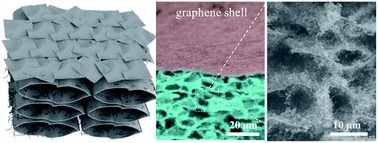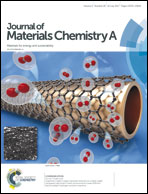A bifunctional hierarchical porous carbon network integrated with an in situ formed ultrathin graphene shell for stable lithium–sulfur batteries†
Abstract
For the development of high-performance Li–S batteries, the issues of the insulating nature of sulfur and shuttle effect of polysulfides need to be well addressed simultaneously, which require elaborate structure design of a suitable host for sulfur. In this work, a novel bifunctional and free-standing sulfur cathode consisted of a hierarchical porous carbon network as the conductive host for sulfur and an in situ formed graphene shell as the top layer for physical blocking of the shuttle effect is carefully fabricated. Owing to filtration assembly, an ultrathin graphene shell (∼100 nm in thickness) is in situ formed firstly, on which a macroporous graphene architecture is gradually deposited afterwards. Subsequent chemical vapor deposition of interwoven CNTs on both sides of graphene sheets generates numerous nano-sized cavities for loading of sulfur nanoparticles. The rationally designed electrode possesses a relatively high areal sulfur loading of ∼3.6 mg cm−2, and shows excellent rate capability at ∼6.0 mA cm−2 and cyclic stability over 200 cycles. And as the graphene nano-shell blocks the diffusion of polysulfides, the anti-self-discharge capability of the cell is remarkably improved.



 Please wait while we load your content...
Please wait while we load your content...